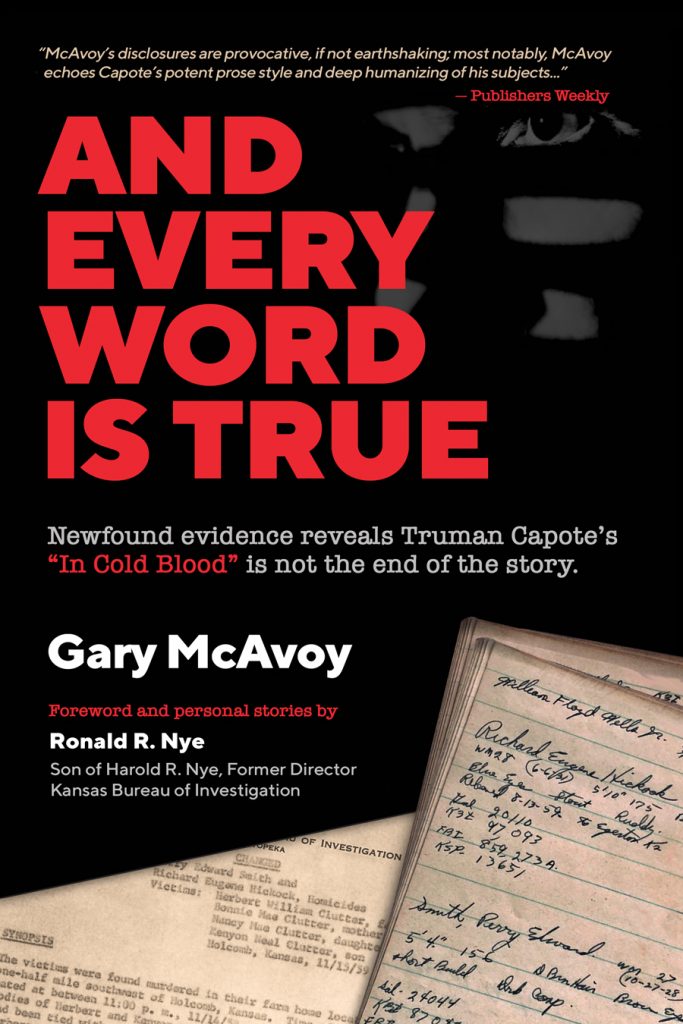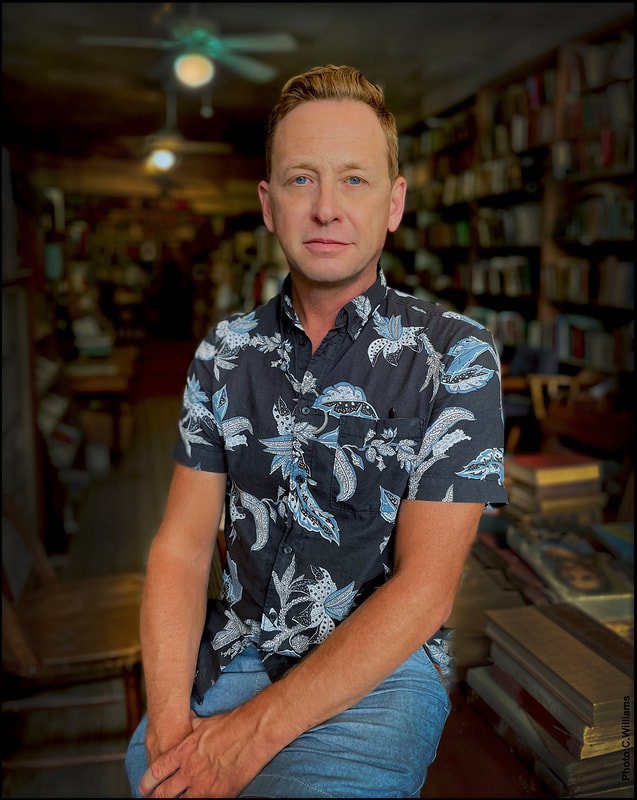New Evidence on ‘In Cold Blood’ Sixty Years Later
An interview with Gary McAvoy, author of And Every Word is True, a new book about the Clutter murders that proposes Truman Capote’s book was not the end of the story.

In his “Acknowledgements,” author Gary McAvoy says his book “would never have been possible without the new friend I made in Ron Nye, when in 2012 he turned to me in a time of need to reluctantly sell his father’s books and letters from Truman Capote.”
Fans of In Cold Blood may recognize the Nye name from Harold Nye, Ron’s father, a special agent at the time of the Clutter family murders and later director of the Kansas Bureau of Investigation (KBI).
Ron Nye found a box of his dad’s materials in a dumpster after his mother cleaned out her late husband’s files and rescued it as a way to remember his father. That box contained two notebooks Harold had used during the investigation, along with letters from Truman Capote and signed first editions of In Cold Blood and Selected Writings. In Cold Blood also happened to be signed by 12 other people, including investigators on the case like Alvin Dewey and the director, actors and crew of the 1967 film.
Due to mounting medical expenses in his family, Ron decided to try and sell the memorabilia. Christie’s referred him to Vintage Memorabilia in Seattle owned by Gary McAvoy. McAvoy already dealt in rare historical letters, manuscripts and books so he was, of course, thrilled about the Capote memorabilia, but he had no idea the interest Harold Nye’s notebooks would spark.
Ron felt that all of the material should stay together, so after doing some extensive research and rereading In Cold Blood, McAvoy got an online catalog together in preparation for auction. They decided to exclude crime scene photos that were originally part of the discovery, because they were thought to be too gruesome for public release. They instead sent the photos to the KBI for archive purposes. A few days later, a cease and desist letter arrived from the Kansas attorney general claiming that Harold Nye’s personal journals were state property and contained “highly confidential information.”
What ensued was a grueling six-year legal battle that aimed to keep the information McAvoy possessed from ever reaching public consumption. Available November 15, And Every Word is True is proof that justice was on McAvoy—and Nye’s—side, but we interviewed McAvoy about how this book came to be, what he discovered in that box Nye saved from the trash that the KBI so wanted kept secret and why he thinks the story of In Cold Blood is still as fascinating as it was six decades ago.
Erin Z. Bass: Your book has taken about seven years to come to light after being held up in court and basically blocked at every turn. Do you feel you can now identify with Truman Capote’s frustration over having to wait so long to publish In Cold Blood?

Gary McAvoy: Yes, absolutely. In fact, while researching and writing my book, I was constantly reminded of Capote’s own frustrations in finishing his own book, and we both took about the same time completing it. Each of us dealt with roadblocks—his, waiting for the “ending,” whether that was execution or life sentences for Smith and Hickock. In my case, it was whether or not the court would allow us to publish.
EZB: What was the result of all your legal proceedings and why were you finally able to publish this book?
GM: There were two aspects of our court case with the State of Kansas. First, whether we had the right to publish Harold Nye’s materials or not; and, second, who actually owned the materials, the state or Harold Nye’s son Ronald. In the first decision, the court ruled in our favor, that we did have the right to publish. As we began the second prong of the litigation, the matter of ownership, the state abruptly dropped the lawsuit, knowing that if they allowed it to proceed we would have exercised our right to due diligence, permitting us to ask for and receive everything the KBI had in its files on the Clutter murder investigation. Apparently they did not want that to happen, so they dropped the case, ending the lawsuit.
EZB: When Ron Nye first contacted you in 2012 about what some would consider a literary goldmine, what were your initial thoughts? Did you have any idea of the value of the materials Ron possessed?
GM: As a rare literary manuscripts dealer, I certainly knew the value of the two signed books and two handwritten letters Capote had sent to Harold Nye, which were especially valuable since they had association to a major literary work and a famous American crime. As for the batch of investigative reports and other materials that Ron Nye also sent, I hadn’t attributed much value to them at all, frankly, since they were deemed as extraneous and did not fall into a particular collectible category—until, that is, I read them. That’s when I knew there was much more here than a simple memorabilia auction.
EZB: How much did you know about Truman Capote and the In Cold Blood saga?

GM: I’d read In Cold Blood many years before and have collected Truman Capote’s autograph material—books, letters and other materials—for many years. But when I received the Nye archives, I re-read Capote’s book and, in later research, learned as much as I could on the Clutter murder investigation. That set the stage for a more informed book that Ron and I could be proud of.
EZB: What do you think are the most valuable/significant parts of Ron’s collection? Is it Harold Nye’s notebooks, the crime scene photos, the signed book copies or something else?
GM: Most definitely that would be Harold Nye’s handwritten notebooks, two reporters’ steno pads filled with on-the-scene reports of his investigative activities. It was like being there, reading his notations, thoughts and descriptions of the crime.
EZB: Can you describe your dealings with the KBI and why you think they felt so threatened by your possession of this material?
GM: In the beginning, I believe the KBI genuinely felt it was trying to retrieve what it assumed were original documents belonging to its official case file of the Clutter murders. But the fact is Nye’s archive comprised only copies of reports, which by statute at the time were fully permissible for agents to retain in their personal files, as the court later ruled. Later, once the KBI read what Nye’s personal notebooks revealed, I can only assume they did not want its contents to be made public. They never made a judgment or opinion one way or the other, so that remains an assumption on my part.
EZB: Your book’s title is And Every Word is True, and you write a lot about the accuracy of Capote’s In Cold Blood? Why does it matter whether or not his book was an accurate account of the murders and how did that inform your story?
GM: In a 1966 Newsweek interview, Truman Capote was quoted as stating emphatically that, “[his book is] a completely factual account and every word is true.” While I never set out to disprove or denigrate Capote’s fine work, the information I uncovered in my research can be fully supported by official documents and acts in contradiction to much of what Capote had written.
EZB: Your book claims to present newfound evidence of the murders and the investigation, like the idea that Herb Clutter was having an affair and Dick and Perry may have met with a man named Robert after the murders to receive payment. How do these new details change this 60-year-old story and why would the KBI have wanted to keep them a secret?
GM: In Cold Blood portrayed Herbert Clutter as a virtuous pillar of the community, yet not only were there eyewitnesses to his being publicly intimate with a married woman, not his wife, and the town having known about his alleged infidelity, this example alone could have been motive for a revenge killing. (He would hardly have been the first of such victims.) As for why the KBI might have wanted to keep this kind of information secret, I really can’t figure that out, except perhaps in deference to the surviving Clutter family.
EZB: Where does the story of In Cold Blood stand now, 60 years later? And why do you think it’s still as compelling as it was in the 1960s?
GM: My book does shed light on many questions readers of In Cold Blood have had for decades (such as why did Smith and Hickock murder an entire family for just $40?). Capote put phenomenal effort into crafting a well-told story, and since it always ranks among the Top 100 American novels, readers will continue enjoying its memorable prose and themes, even if it scares them.
EZB: Did your impressions of Truman Capote (and also Harper Lee, who some would argue made In Cold Blood possible) change after researching and writing this book?
GM: I felt a great deal more sympathy for Harper Lee after learning so much about their lifelong relationship and Capote’s dismissal of her not insignificant efforts assisting him. She accomplished much more than he ever credited her for, sadly. As for Capote, I still admire his work greatly, though I doubt he’s the kind of person I’d want to be friends with. (Though sharing a martini together while he told boundless stories sounds like a good evening … )




Ann / April 14, 2020
Way late but you might want to correct the photo caption…that is Capote with the actors who starred in the movie version of In Cold Blood.